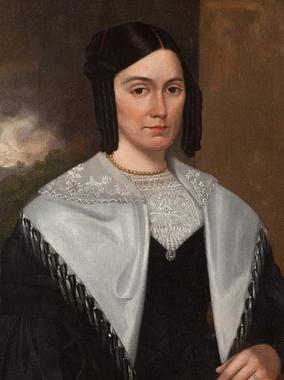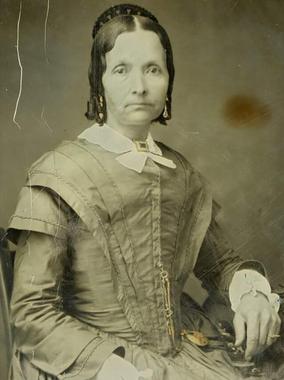- Topsfield
- D11-Cover.jpg
- D11-Page-145-b.jpg
- D11-Page-154-a.jpg
- D11-Page-303.jpg
- D11-Page-336.jpg
- D11-Page-290.jpg
| Temple Square is always beautiful in the springtime. Gardeners work to prepare the ground for General Conference. © 2012 Intellectual Reserve, Inc. All rights reserved. | 1 / 2 |
This story appears here courtesy of TheChurchNews.com. It is not for use by other media.
By Sydney Walker, Church News
As possible arrest and extradition continued to threaten Joseph Smith in late September 1842, Emma Smith became deathly ill.
Joseph stayed by his wife’s side and attended to her needs — until he learned law officers were once again heading to Nauvoo, Illinois, to arrest him. He was forced to flee and leave Emma behind.
Rampant rumors accused him of attempting to assassinate former Missouri Gov. Lilburn W. Boggs. Joseph knew that if he was taken to Missouri, he wouldn’t return.

D11-Page-145-b.jpg
Portrait of Emma Smith, September 1842. Photo courtesy of the Community of Christ Library-Archives, licensed to Joseph Smith Papers Project. All rights reserved.Days later, word reached the Smith family home that Joseph made it safely to his hiding place, about 30 miles northeast of Nauvoo. Eliza R. Snow, who had moved into the Smith family home in August at Emma’s request, composed a private letter she sent to Joseph in the form of a poem:
“Sir, for your consolation permit me to tell
That your Emma is better — she soon will be well;
Mrs. [Elizabeth Davis] Durfee stands by her, night & day like a friend
And is prompt every call — every wish to attend;
Then pray for your Emma, but indulge not a fear
For the God of our forefathers, smiles on us here.”
In the rest of her letter dated October 12, 1842, Eliza apprised Joseph of Emma’s health and encouraged him to “be of good cheer” while in exile. “May the God of our forefathers screen you from ill,” she wrote.

D11-Page-154-a.jpg
In October 1842, after Joseph Smith went into hiding, Eliza R. Snow (photographed circa 1856) wrote to him concerning Emma Smith’s health, assuring him that she and Elizabeth Davis Durfee were doing their best to care for Emma. Photo courtesy of the Church History Library. 2020 by Intellectual Reserve, Inc. All rights reserved.This letter is one of 105 documents — and one of two poems penned by Eliza — that appear in “The Joseph Smith Papers, Documents Volume 11: September 1842–February 1843,” released October 12.
Throughout this time period, Joseph was in and out of hiding, which affected his work as mayor of Nauvoo and president of The Church of Jesus Christ of Latter-day Saints.
“Yet, in the midst of that turmoil, in the midst of that tumult, we get some of the most stirring documents that are ever written by Joseph Smith,” said Jeffrey D. Mahas, historian and volume editor.
Recording Proxy Baptisms
Compared to previous volumes, this one does not contain many discourses or meeting minutes, as Joseph is not able to participate in the regular business of the Church in Nauvoo, said Spencer W. McBride, lead historian on volume 11.
However, “It seems that when Joseph is in hiding, he has time to reflect and ponder on things, and this leads to new revelations,” he said.
For example, Joseph wrote two letters to the Saints in September 1842 that have since been canonized as Doctrine and Covenants 127 and 128. He outlined direction on recording baptisms for the dead and taught that the ordinance was vital to creating “a welding link” between generations.
To paraphrase Joseph’s writing, “The records we keep on earth are mirrored by records kept in heaven,” McBride said. “So it’s not just the proxy baptisms that we perform on earth that matter. It’s the record that’s kept of them that will allow them to be efficacious in the next life.”
The conclusion of Joseph’s second letter — “Shall we not go on in so great a cause? Go forward and not backward. Courage, brethren …” — is an oft-quoted passage by Church leaders today. In fact, “Shall We Not Go On in So Great a Cause?” was the title of President M. Russell Ballard’s April 2020 general conference address.
Joseph Smith’s Leadership
Toward the end of October 1842, Joseph was back in Nauvoo. After surveying the progress on the Nauvoo temple one day, he greeted a group of Latter-day Saint converts who had arrived on a steamboat from New York. Much of the rapid growth Nauvoo experienced during this time came from new converts flocking to the city.
Some of these converts had high expectations of “a glistening city on a hill” with a “more than human” prophet, and they became easily dissatisfied, McBride explained. In this particular account, Joseph took the time to welcome the new converts and help temper their expectations.
As a scribe recorded in Joseph’s journal on October 29, 1842, “He says he was but a man and they must not expect him to be perfect; if they expected perfection from him, he should expect it from them, but if they would bear with his infirmities and the infirmities of the brethren, he would likewise bear with their infirmities.”
This discourse reveals the “very realistic approach Joseph Smith took to his prophetic leadership” and perhaps provides a lens through which to view the history of the Church, McBride said.
“For me as a Latter-day Saint — not just as an historian — I think this way of thinking about Joseph Smith is remarkably helpful as we dive into the history of the early Latter-day Saints. We shouldn’t expect perfection of early Church leaders,” he added.
A ‘Win’ for the Saints
With the extradition attempt ongoing, several of Joseph’s friends and associates communicated with state officials, seeking legal defense on his behalf. That defense came in December when Joseph’s attorney convincingly noted that Missouri had no legal claim — Joseph was in Illinois at the time of the crime and had not fled Missouri.
To officially settle the issue in court, Joseph submitted to a prearranged arrest and traveled to the hearing in Springfield, Illinois, in January. The federal district judge ruled in Joseph’s favor, and he was released from custody.
“This is a super triumphant moment for Joseph Smith because he had had this weight of Missouri trying to get him back,” McBride said. “There’s a palpable sense of relief among the Saints in Nauvoo. … They see Nauvoo’s future as very bright. They see Nauvoo as a place that is actually going to protect them from their enemies.”
The Saints set aside a day of fasting, prayer and jubilation in celebration of Joseph’s safe return to Nauvoo. In preparation for this event, Eliza wrote a jubilee song. The beginning of Eliza’s song reads:
“That deed — that time we celebrate,
So rife with liberty;
When the official pow’rs of State
Pronounc’d the Prophet free.
When foul oppression’s hand was stay’d —
A feast of Liberty,
The Prophet and his Lady made,
To crown the jubilee.”

D11-Page-336.jpg
Joseph Smith commissioned this broadside of songs commemorating his legal victory in Springfield, Illinois. He personally distributed copies of the songs at a party held January 18, 1843, to celebrate his release. Photo courtesy of Church History Library. 2020 by Intellectual Reserve, Inc. All rights reserved.This song was one of two printed on paper and handed out to guests to sing during Joseph and Emma’s celebratory dinner party. The other was written by Wilson Law and Willard Richards.
History reveals that this is not the end of troubles for the Saints, Mahas said. But at this moment, “They are thinking, ‘Our worst days are behind us. We’ve made it.’ … You can feel the excitement, you can feel the joy and hope that they have for the future moving forward.”
Earlier this year, the Church Historian’s Press published diaries of Emmeline B. Wells, discourses of Eliza R. Snow and “The Joseph Smith Papers: Documents, Volume 10: May–August 1842.” Learn more about the Church Historian’s Press at churchhistorianspress.org.
Copyright 2020 Deseret News Publishing Company